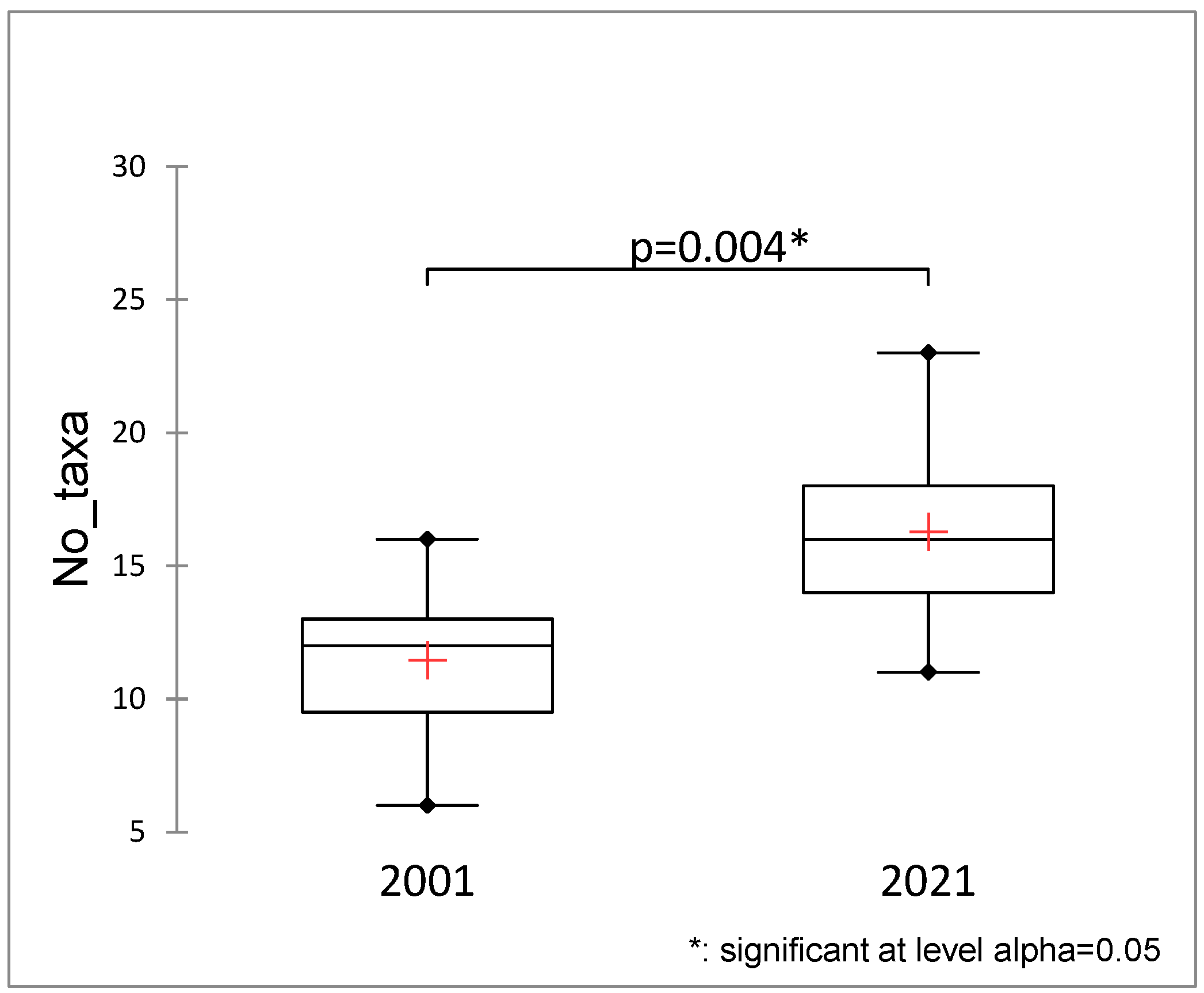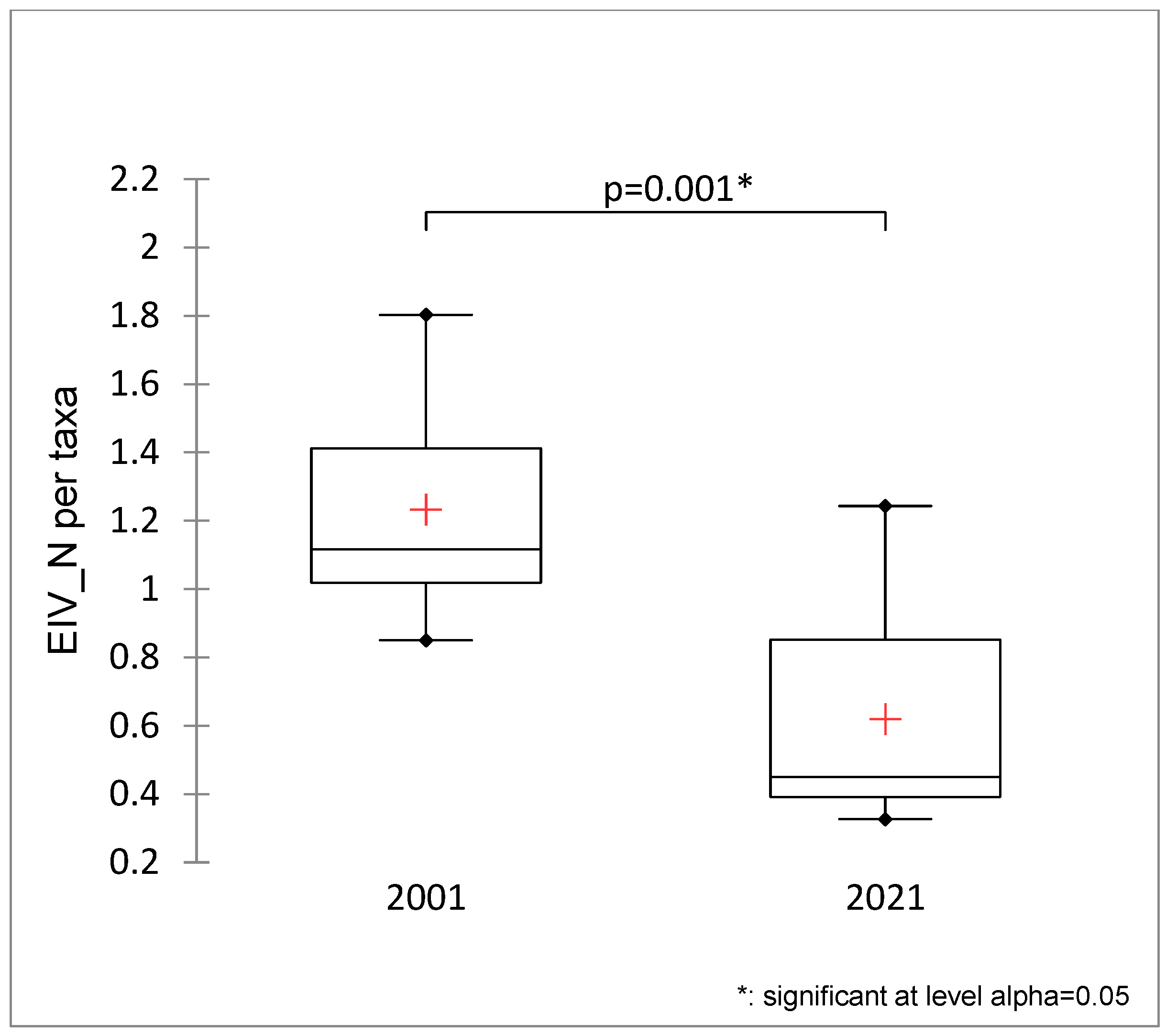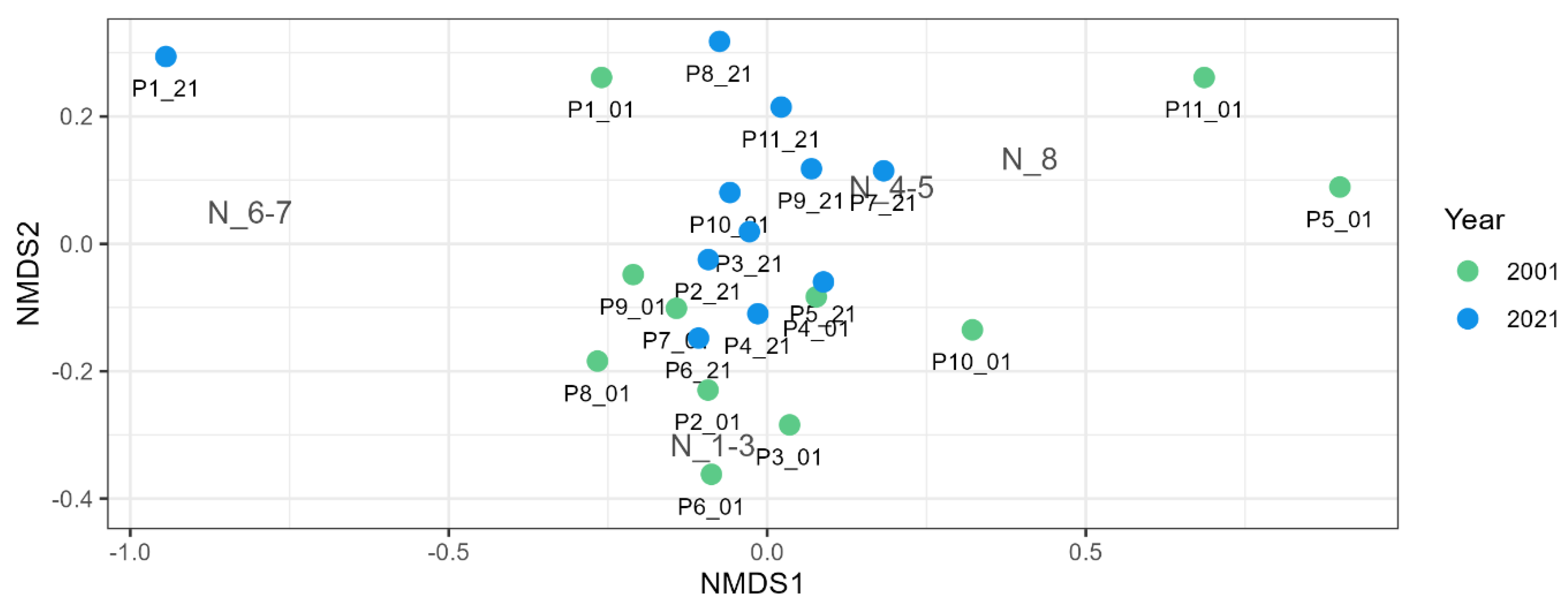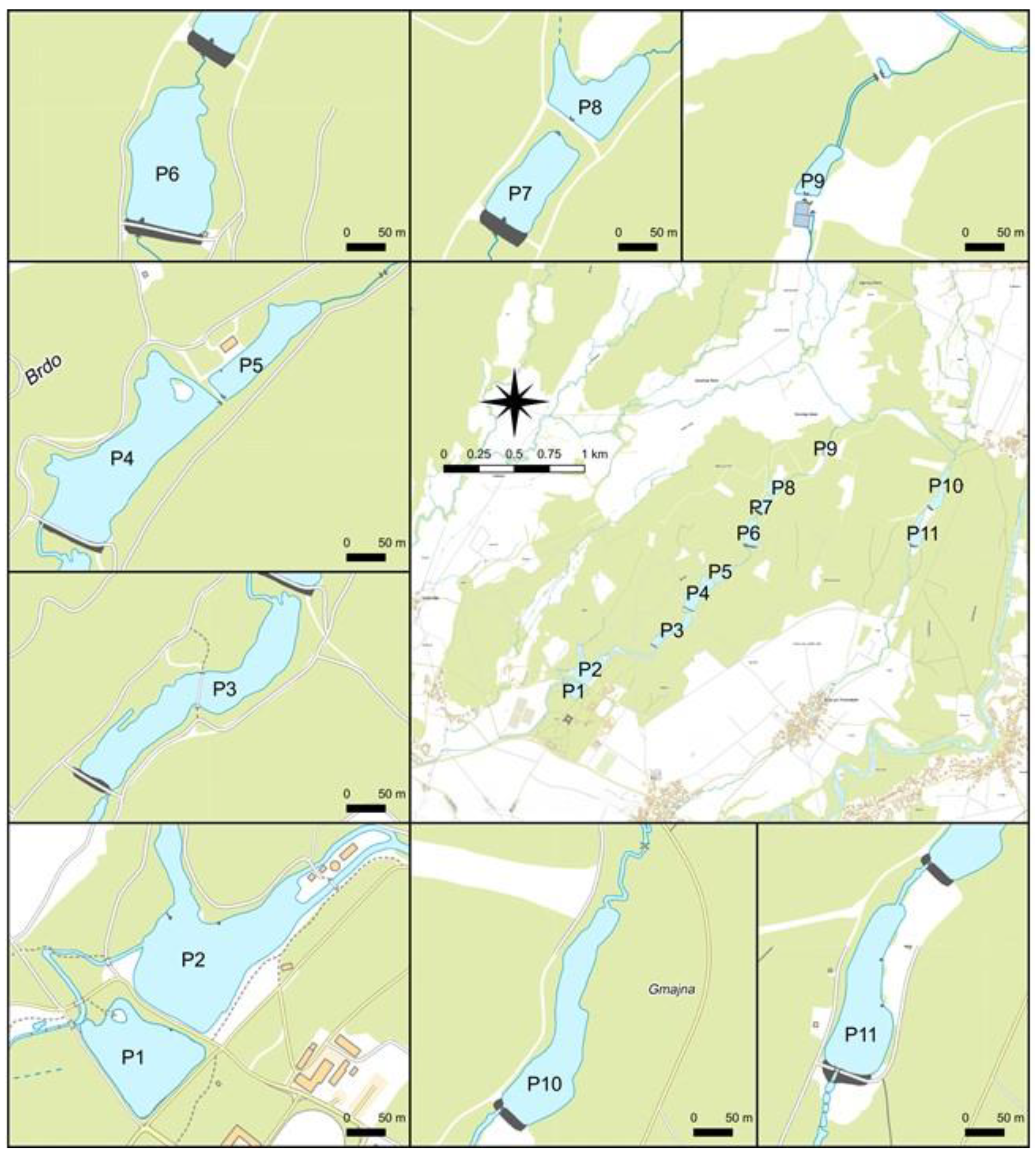Aquatic Plants in Ponds at the Brdo Estate (Slovenia) Show Changes in 20 Years
Abstract
1. Introduction
2. Results
2.1. Presence and Abundance of Macrophyte Taxa in Years 2001 and 2021
2.2. Effect of Physical and Chemical Properties on the Distribution of Macrophytes in Ponds in 2021
3. Discussion
3.1. Presence and Abundance of Macrophyte Taxa in Years 2001 and 2021
3.2. Effect of Physical and Chemical Properties on the Distribution of Macrophytes in Ponds in 2021
4. Materials and Methods
4.1. Study Area
4.2. Sampling Design
4.3. Macrophyte Survey
4.4. Physical and Chemical Parameters of Water
4.5. Statistical Analysis
5. Conclusions
Supplementary Materials
Author Contributions
Funding
Institutional Review Board Statement
Data Availability Statement
Acknowledgments
Conflicts of Interest
References
- Kolada, A. The Use of Aquatic Vegetation in Lake Assessment: Testing the Sensitivity of Macrophyte Metrics to Anthropogenic Pressures and Water Quality. Hydrobiologia 2010, 656, 133–147. [Google Scholar] [CrossRef]
- Poikane, S.; Portielje, R.; Denys, L.; Elferts, D.; Kelly, M.; Kolada, A.; Mäemets, H.; Phillips, G.; Søndergaard, M.; Willby, N.; et al. Macrophyte Assessment in European Lakes: Diverse Approaches but Convergent Views of ‘Good’ Ecological Status. Ecol. Indic. 2018, 94, 185–197. [Google Scholar] [CrossRef]
- Søndergaard, M.; Phillips, G.; Hellsten, S.; Kolada, A.; Ecke, F.; Mäemets, H.; Mjelde, M.; Azzella, M.M.; Oggioni, A. Maximum Growing Depth of Submerged Macrophytes in European Lakes. Hydrobiologia 2013, 704, 165–177. [Google Scholar] [CrossRef]
- Scheffer, M.; Van Geest, G.J.; Zimmer, K.; Jeppesen, E.; Søndergaard, M.; Butler, M.G.; Hanson, M.A.; Declerck, S.; De Meester, L. Small Habitat Size and Isolation Can Promote Species Richness: Second-Order Effects on Biodiversity in Shallow Lakes and Ponds. Oikos 2006, 112, 227–231. [Google Scholar] [CrossRef]
- Burdett, A.S.; Watts, R.J. Modifying Living Space: An Experimental Study of the Influences of Vegetation on Aquatic Invertebrate Community Structure. Hydrobiologia 2009, 618, 161–173. [Google Scholar] [CrossRef]
- Della Bella, V.; Bazzanti, M.; Chiarotti, F. Macroinvertebrate Diversity and Conservation Status of Mediterranean Ponds in Italy: Water Permanence and Mesohabitat Influence. Aquat. Conserv. Mar. Freshw. Ecosyst. 2005, 15, 583–600. [Google Scholar] [CrossRef]
- Zelnik, I.; Gregorič, N.; Tratnik, A. Diversity of Macroinvertebrates Positively Correlates with Diversity of Macrophytes in Karst Ponds. Ecol. Eng. 2018, 117, 96–103. [Google Scholar] [CrossRef]
- Kuiper, J.J.; Verhofstad, M.J.J.M.; Louwers, E.L.M.; Bakker, E.S.; Brederveld, R.J.; van Gerven, L.P.A.; Janssen, A.B.G.; de Klein, J.J.M.; Mooij, W.M. Mowing Submerged Macrophytes in Shallow Lakes with Alternative Stable States: Battling the Good Guys? Environ. Manag. 2017, 59, 619–634. [Google Scholar] [CrossRef]
- Downing, J.A.; Prairie, Y.T.; Cole, J.J.; Duarte, C.M.; Tranvik, L.J.; Striegl, R.G.; McDowell, W.H.; Kortelainen, P.; Caraco, N.F.; Melack, J.M.; et al. The Global Abundance and Size Distribution of Lakes, Ponds, and Impoundments. Limnol. Oceanogr. 2006, 51, 2388–2397. [Google Scholar] [CrossRef]
- Williams, P.; Whitfield, M.; Biggs, J.; Bray, S.; Fox, G.; Nicolet, P.; Sear, D. Comparative Biodiversity of Rivers, Streams, Ditches and Ponds in an Agricultural Landscape in Southern England. Biol. Conserv. 2004, 115, 329–341. [Google Scholar] [CrossRef]
- Downing, J.A. Emerging Global Role of Small Lakes and Ponds: Little Things Mean a Lot. Limnetica 2010, 29, 9–24. [Google Scholar] [CrossRef]
- Céréghino, R.; Ruggiero, A.; Marty, P.; Angélibert, S. Biodiversity and Distribution Patterns of Freshwater Invertebrates in Farm Ponds of a South-Western French Agricultural Landscape. Hydrobiologia 2008, 597, 43–51. [Google Scholar] [CrossRef]
- Lougheed, V.L.; Mcintosh, M.D.; Parker, C.A.; Stevenson, J.R. Wetland Degradation Leads to Homogenization of the Biota at Local and Landscape Scales. Freshw. Biol. 2008, 53, 2402–2413. [Google Scholar] [CrossRef]
- Cole, J.J.; Prairie, Y.T.; Caraco, N.F.; McDowell, W.H.; Tranvik, L.J.; Striegl, R.G.; Duarte, C.M.; Kortelainen, P.; Downing, J.A.; Middelburg, J.J.; et al. Plumbing the Global Carbon Cycle: Integrating Inland Waters into the Terrestrial Carbon Budget. Ecosystems 2007, 10, 172–185. [Google Scholar] [CrossRef]
- Taylor, S.; Gilbert, P.J.; Cooke, D.A.; Deary, M.E.; Jeffries, M.J. High Carbon Burial Rates by Small Ponds in the Landscape. Front. Ecol. Environ. 2019, 17, 25–31. [Google Scholar] [CrossRef]
- Lukács, B.A.; Tóthmérész, B.; Borics, G.; Várbíró, G.; Juhász, P.; Kiss, B.; Müller, Z.; G-Tóth, L.; Eros, T. Macrophyte Diversity of Lakes in the Pannon Ecoregion (Hungary). Limnologica 2015, 53, 74–83. [Google Scholar] [CrossRef]
- Bolpagni, R.; Poikane, S.; Laini, A.; Bagella, S.; Bartoli, M.; Cantonati, M. Ecological and Conservation Value of Small Standing-Water Ecosystems: A Systematic Review of Current Knowledge and Future Challenges. Water 2019, 11, 402. [Google Scholar] [CrossRef]
- Shutoh, K.; Yamanouchi, T.; Kato, S.; Yamagishi, H.; Ueno, Y.; Hiramatsu, S.; Nishihiro, J.; Shiga, T. The Aquatic Macrophyte Flora of a Small Pond Revealing High Species Richness in the Aomori Prefecture, Japan. J. Asia-Pac. Biodivers. 2019, 12, 448–458. [Google Scholar] [CrossRef]
- Álvarez, X.; Valero, E.; Santos, R.M.B.; Varandas, S.G.P.; Sanches Fernandes, L.F.; Pacheco, F.A.L. Anthropogenic Nutrients and Eutrophication in Multiple Land Use Watersheds: Best Management Practices and Policies for the Protection of Water Resources. Land Use Policy 2017, 69, 1–11. [Google Scholar] [CrossRef]
- Akasaka, M.; Takamura, N.; Mitsuhashi, H.; Kadono, Y. Effects of Land Use on Aquatic Macrophyte Diversity and Water Quality of Ponds. Freshw. Biol. 2010, 55, 909–922. [Google Scholar] [CrossRef]
- Qin, B.; Gao, G.; Zhu, G.; Zhang, Y.; Song, Y.; Tang, X.; Xu, H.; Deng, J. Lake Eutrophication and Its Ecosystem Response. Chin. Sci. Bull. 2013, 58, 961–970. [Google Scholar] [CrossRef]
- Körner, S. Loss of Submerged Macrophytes in Shallow Lakes in North-Eastern Germany. Int. Rev. Hydrobiol. 2002, 87, 375. [Google Scholar] [CrossRef]
- Sand-Jensen, K.; Riis, T.; Vestergaard, O.; Larsen, S.E. Macrophyte Decline in Danish Lakes and Streams over the Past 100 Years. J. Ecol. 2000, 88, 1030–1040. [Google Scholar] [CrossRef]
- Gulati, R.D.; van Donk, E. Lakes in the Netherlands, Their Origin, Eutrophication and Restoration: State-of-the-Art Review*. Hydrobiologia 2002, 478, 73–106. [Google Scholar] [CrossRef]
- Blindow, I. Decline of Charophytes during Eutrophication: Comparison with Angiosperms. Freshw. Biol. 1992, 28, 9–14. [Google Scholar] [CrossRef]
- Zhang, Y.; Jeppesen, E.; Liu, X.; Qin, B.; Shi, K.; Zhou, Y.; Thomaz, S.M.; Deng, J. Global Loss of Aquatic Vegetation in Lakes. Earth-Sci. Rev. 2017, 173, 259–265. [Google Scholar] [CrossRef]
- Portielje, R.; Roijackers, R.M.M. Aquatic Botany Primary Succession of Aquatic Macrophytes in Experimental Ditches in Relation to Nutrient Input. Aquat. Bot. 1995, 50, 127–140. [Google Scholar] [CrossRef]
- Janssen, A.; Hunger, H.; Konold, W.; Pufal, G.; Staab, M. Simple Pond Restoration Measures Increase Dragonfly (Insecta: Odonata) Diversity. Biodivers. Conserv. 2018, 27, 2311–2328. [Google Scholar] [CrossRef]
- Sayer, C.D.; Greaves, H.M. Making an Impact on UK Farmland Pond Conservation. Aquat. Conserv. Mar. Freshw. Ecosyst. 2020, 30, 1821–1828. [Google Scholar] [CrossRef]
- Hassall, C.; Hollinshead, J.; Hull, A. Environmental Correlates of Plant and Invertebrate Species Richness in Ponds. Biodivers. Conserv. 2011, 20, 3189–3222. [Google Scholar] [CrossRef]
- Hill, M.J.; Greaves, H.M.; Sayer, C.D.; Hassall, C.; Milin, M.; Milner, V.S.; Marazzi, L.; Hall, R.; Harper, L.R.; Thornhill, I.; et al. Pond Ecology and Conservation: Research Priorities and Knowledge Gaps. Ecosphere 2021, 12, e03853. [Google Scholar] [CrossRef]
- Wang, L.; Han, Y.; Yu, H.; Fan, S.; Liu, C. Submerged Vegetation and Water Quality Degeneration From Serious Flooding in Liangzi Lake, China. Front. Plant Sci. 2019, 10, 462912. [Google Scholar] [CrossRef] [PubMed]
- Alahuhta, J.; Heino, J.; Luoto, M. Climate Change and the Future Distributions of Aquatic Macrophytes across Boreal Catchments. J. Biogeogr. 2011, 38, 383–393. [Google Scholar] [CrossRef]
- Lind, L.; Eckstein, R.L.; Relyea, R.A. Direct and Indirect Effects of Climate Change on Distribution and Community Composition of Macrophytes in Lentic Systems. Biol. Rev. 2022, 97, 1677–1690. [Google Scholar] [CrossRef]
- Bloechl, A.; Koenemann, S.; Philippi, B.; Melber, A. Abundance, Diversity and Succession of Aquatic Coleoptera and Heteroptera in a Cluster of Artificial Ponds in the North German Lowlands. Limnologica 2010, 40, 215–225. [Google Scholar] [CrossRef]
- Phillips, G.; Kelly, A.; Pitt, J.A.; Sanderson, R.; Taylor, E. The Recovery of a Very Shallow Eutrophic Lake, 20 Years after the Control of Effluent Derived Phosphorus. Freshw. Biol. 2005, 50, 1628–1638. [Google Scholar] [CrossRef]
- Bakker, E.S.; Sarneel, J.M.; Gulati, R.D.; Liu, Z.; van Donk, E. Restoring Macrophyte Diversity in Shallow Temperate Lakes: Biotic versus Abiotic Constraints. Hydrobiologia 2013, 710, 23–37. [Google Scholar] [CrossRef]
- RS, U. Uradni List RS Št. 82/2002. 2002. Available online: https://www.uradni-list.si/_pdf/2002/Ur/u2002082.pdf (accessed on 19 September 2023).
- Wiegleb, G.; Brux, H.; Herr, W. Human Impact on the Ecological Performance of Potamogeton Species in Northwestern Germany. Vegetatio 1991, 97, 161–172. [Google Scholar] [CrossRef]
- Preston, C.D. Pondweeds of Great Britain and Ireland; Botanical Society of Britain & Ireland: St Albans, UK, 1995. [Google Scholar]
- Johnsen, T.J.; Henriksen, L.D.R.; Larsen, M.B.; Kallestrup, H.; Larsen, S.E.; Riis, T.; Baattrup-Pedersen, A. Rare Potamogeton Species Can Establish in Restored Danish Lowland Stream Reaches. Freshw. Biol. 2022, 67, 518–532. [Google Scholar] [CrossRef]
- Lambert, S.J.; Davy, A.J. Water Quality as a Threat to Aquatic Plants: Discriminating between the Effects of Nitrate, Phosphate, Boron and Heavy Metals on Charophytes. New Phytol. 2011, 189, 1051–1059. [Google Scholar] [CrossRef]
- Han, X.; Rusconi, N.; Ali, P.; Pagkatipunan, K.; Chen, F. Nutrients Extracted from Chicken Manure Accelerate Growth of Microalga Scenedesmus obliquus HTB1. Green Sustain. Chem. 2017, 07, 101–113. [Google Scholar] [CrossRef]
- Heikkinen, R.; Leikola, N.; Fronzek, S.; Lampinen, R.; Toivonen, H. Predicting Distribution Patterns and Recent Northward Range Shift of an Invasive Aquatic Plant: Elodea Canadensis in Europe. BioRisk 2009, 2, 1–32. [Google Scholar] [CrossRef]
- Yang, C.; Shi, X.; Nan, J.; Huang, Q.; Shen, X.; Li, J. Morphological Responses of the Submerged Macrophyte Vallisneria Natans along an Underwater Light Gradient: A Mesocosm Experiment Reveals the Importance of the Secchi Depth to Water Depth Ratio. Sci. Total Environ. 2022, 808, 152199. [Google Scholar] [CrossRef] [PubMed]
- Ojdanič, N.; Germ, M.; Andlovic, M.; Černela, D.; Zelnik, I. Distribution of Aquatic Macrophytes in the Littoral of Lake Bohinj (Slovenia). Diversity 2023, 15, 1115. [Google Scholar] [CrossRef]
- Jones, J.I.; Young, J.O.; Eaton, J.W.; Moss, B. The Influence of Nutrient Loading, Dissolved Inorganic Carbon and Higher Trophic Levels on the Interaction between Submerged Plants and Periphyton. J. Ecol. 2002, 90, 12–24. [Google Scholar] [CrossRef]
- Wu, H.; Hao, B.; Jo, H.; Cai, Y. Seasonality and Species Specificity of Submerged Macrophyte Biomass in Shallow Lakes Under the Influence of Climate Warming and Eutrophication. Front. Plant Sci. 2021, 12, 678259. [Google Scholar] [CrossRef]
- Ge, Y.; Zhang, K.; Yang, X. Long-Term Succession of Aquatic Plants Reconstructed from Palynological Records in a Shallow Freshwater Lake. Sci. Total Environ. 2018, 643, 312–323. [Google Scholar] [CrossRef]
- You, W.; Yu, D.; Xie, D.; Yu, L.; Xiong, W.; Han, C. Responses of the Invasive Aquatic Plant Water Hyacinth to Altered Nutrient Levels under Experimental Warming in China. Aquat. Bot. 2014, 119, 51–56. [Google Scholar] [CrossRef]
- Ogrin, D. Aplikativna Fizična Geografija Slovenije; Filozofska fakulteta, UL: Ljubljana, Slovenia, 2009. [Google Scholar]
- Geister, I. Naravoslovni Sprehodi Na Brdu Pri Kranju; Zavod za favnistiko: Koper, Ljubljana, 2009. [Google Scholar]
- Kohler, A.; Janauer, G.A. Zur Methodik Der Untersuchung von Aquatischen Makrophyten in Fließgewässern. In Handbuch Angewandte Limnologie; Steinberg, C., Bernhardt, H., Klapper, H., Eds.; Ecomed Verlag: Landsberg am Lech, Germany, 1995; pp. 3–22. [Google Scholar]
- Engloner, A.I. Alternative Ways to Use and Evaluate Kohler’s Ordinal Scale to Assess Aquatic Macrophyte Abundance. Ecol. Indic. 2012, 20, 238–243. [Google Scholar] [CrossRef]
- Janauer, G.; Kvet, J.; Germ, M.; Gaberščik, A. Macrophytes of the River Danube Basin, 1st ed.; Academia: Praha, Czech Republic, 2018. [Google Scholar]
- Ellenberg, H.; Weber, H.E.; Düll, R.; Wirth, V.; Werner, W.; Paulissen, D. Zeigerwerte von Pflanzen in Mitteleuropa. 3. Durchgesehene Auflage; Verlag Erich Goltze KG: Göttingen, Germany, 2001. [Google Scholar]
- ter Braak, C.J.F.; Verdonschot, P.F.M. Canonical Correspondence Analysis and Related Multivariate Methods in Aquatic Ecology. Aquat. Sci. 1995, 57, 255–289. [Google Scholar] [CrossRef]
- ter Braak, C.J.F.; Smilauer, P. Canoco Reference Manual and User’s Guide: Software for Ordination, Version 5.0; Microcomputer Power: Ithaca, NY, USA, 2012. [Google Scholar]









| Pond and Year | P1 ′01 | P1 ′22 | P2 ′01 | P2 ′22 | P3 ′01 | P3 ′22 | P4 ′01 | P4 ′22 | P5 ′01 | P5 ′22 | P6 ′01 | P6 ′22 | P7 ′01 | P7 ′22 | P8 ′01 | P8 ′22 | P9 ′01 | P9 ′22 | P10 ′01 | P10 ′22 | P11 ′01 | P11 ′22 | |
|---|---|---|---|---|---|---|---|---|---|---|---|---|---|---|---|---|---|---|---|---|---|---|---|
| Nr. of SM taxa | 4 | 1 | 0 | 2 | 0 | 0 | 2 | 1 | 0 | 0 | 4 | 0 | 3 | 2 | 2 | 5 | 2 | 1 | 1 | 1 | 3 | 4 | |
| Abundance of SM taxa | 9 | 2 | 0 | 4 | 0 | 0 | 6 | 1 | 0 | 0 | 12 | 0 | 8 | 3 | 8 | 9 | 8 | 1 | 5 | 4 | 8 | 9 | |
| Plant taxa | 14 | 11 | 9 | 23 | 10 | 15 | 12 | 17 | 6 | 16 | 16 | 20 | 15 | 14 | 12 | 14 | 12 | 14 | 11 | 16 | 9 | 19 | |
| SM | Chara sp. | — — — | — — | — — | — | — — — | — — — | — | — | — — — — | — — | ||||||||||||
| SM | Elodea canadensis | — | — — — — — | — — — — — | |||||||||||||||||||
| SM | Myriophyllum spicatum | — — | — — | — — — | — — | — — — | — — — — | ||||||||||||||||
| SM | Potamogeton berchtoldi | — — | — — | ||||||||||||||||||||
| SM | Potamogeton crispus | — — — | — — — | — — — — | — — | — — — — — | |||||||||||||||||
| SM | Potamogeton crispus | — — — — | |||||||||||||||||||||
| SM | Potamogeton lucens | — — — | — — — | ||||||||||||||||||||
| SM | Potamogeton pectinatus | — — | |||||||||||||||||||||
| SM | Potamogeton trichoides | — — | |||||||||||||||||||||
| SM | Ranunculus trichophyllus | — — | — — — — | — — | — — — — | — | — — | — | |||||||||||||||
| FLM | Lemna minor | — | — — | ||||||||||||||||||||
| FLM | Nuphar luteum | — — | — — | ||||||||||||||||||||
| FLM | Nymphaea alba | — — — — | — — — — — | ||||||||||||||||||||
| AM | Gratiola officinalis | — — | |||||||||||||||||||||
| AM | Mentha aquatica | — | — | — — — | — — | — — — | — — | — — | — — | — — | — | — — | — — | — — | — — — | — — | — — | — — — | |||||
| AM | Myosotis scorpioides | — — | |||||||||||||||||||||
| AM | Polygonum amphibium | — | |||||||||||||||||||||
| AM | Veronica beccabunga | — | — | ||||||||||||||||||||
| EM | Alisma plantago-aquatica | — | — | — | — — | — | — | — — | — | ||||||||||||||
| EM | Bidens tripartita | — | |||||||||||||||||||||
| EM | Caltha palustris | — | — — | — | — | — | — | — | — — | — | — | — — | — — | — | — — | — | — | ||||||
| EM | Carex sp. | — — | — — — | — — — | — — | — — — | — | — — — | — — | — | |||||||||||||
| EM | Carex acuta | — — — | — — — | — — | — | — — — | — — | — — | — — — | — — — | — — | ||||||||||||
| EM | Carex davalliana | — | — | ||||||||||||||||||||
| EM | Carex elata | — | — | — — — | — — | — — | — — | — | — — | — — | |||||||||||||
| EM | Carex flava agg. | — | — — — | — — | — — | ||||||||||||||||||
| EM | Chaerophyllum hirsutum | — | — | — | — | ||||||||||||||||||
| EM | Eleocharis palustris | — | — | ||||||||||||||||||||
| EM | Epilobium palustre | — | — — | ||||||||||||||||||||
| EM | Equisetum palustre | — | — — | — | — — | — | — — | — | — | ||||||||||||||
| EM | Galium palustre | — — — | — | — — — | — | — — | — | — | — — | — | — | — | — — | — | — | — | |||||||
| EM | Iris pseudacorus | — — | — — | — | — | ||||||||||||||||||
| EM | Juncus effusus | — | |||||||||||||||||||||
| EM | Juncus inflexus | — | — | — | — | — — | — — | — | — — — | ||||||||||||||
| EM | Leersia oryzoides | — | — — | — — | — | — — | — — | — | — — | — — | — — — | ||||||||||||
| EM | Lycopus europaeus | — | — — — | — | — — | — — | — — | — — | — | — — | — — | — — | — | — — | — — | — | — — | — | — — | — — — | |||
| EM | Lysimachia nummularia | — | — | — | — — | — | — | — | |||||||||||||||
| EM | Lysimachia vulgaris | — | — | — — | — | — — | — | — | — | — | |||||||||||||
| EM | Lythrum salicaria | — — | — | — — | — | — | — | ||||||||||||||||
| EM | Mentha longifolia | — | — — | — — | — — — | — | — — — | — | — — | — | |||||||||||||
| EM | Nasturtium officinale | — | — | — | — | ||||||||||||||||||
| EM | Petasites hybridus | — | — | — | |||||||||||||||||||
| EM | Phalaris arundinacea | — | |||||||||||||||||||||
| EM | Phragmites australis | — | — — | ||||||||||||||||||||
| EM | Rumex hydrolapathum | — | — | ||||||||||||||||||||
| EM | Schoenoplectus lacustris | — — | — — — — | — — | — — | — — — | — | — — — | — — | — — — | — — | — — | |||||||||||
| EM | Scirpus sylvaticus | — | — — | — — | — — — | — — | |||||||||||||||||
| EM | Scutellaria galericulata | — | — | — | — | — | — | — | — — | — | |||||||||||||
| EM | Solanum dulcamara | — | — — — | — | — — | — | — | — — | — | — | — — | — | — | ||||||||||
| EM | Solidago canadensis | — — | |||||||||||||||||||||
| EM | Sparganium erectum agg. | — | — | — | — | — | — — | — — | — — — — | — | — — — — | ||||||||||||
| EM | Typha latifolia | — | — — — | — — | — | — — | — — | — — — | — — | — | — | — — | — | — | — |
| Pond | Temperature (°C) | pH | O2 Saturation (%) | Dissolved O2 (mg/L) | Conductivity (µS/cm) | Nitrate (mg/L) | Secchi Depth (m) | Depth (m) |
|---|---|---|---|---|---|---|---|---|
| P1 | 17.1 | 7.9 | 72 | 6.6 | 417 | 2.02 | 1.0 | 1.0 |
| P2 | 17.8 | 8.3 | 117 | 10.5 | 405 | 2.02 | 1.3 | 3.4 |
| P3 | 16.8 | 8.2 | 111 | 10.2 | 400 | 1.51 | 1.2 | 2.9 |
| P4 | 18.9 | 8.2 | 111 | 9.7 | 389 | 1.54 | 1.4 | 3.2 |
| P5 | 18.2 | 8.0 | 102 | 9.1 | 376 | 1.73 | 0.8 | 1.6 |
| P6 | 19.9 | 8.6 | 119 | 10.3 | 364 | 0.11 | 1.2 | 2.8 |
| P7 | 16.8 | 8.6 | 127 | 11.7 | 385 | 0.96 | 1.3 | 3.1 |
| P8 | 16.1 | 8.7 | 134 | 12.4 | 396 | 2.66 | 2.9 | 4.1 |
| P9 | 11.5 | 7.8 | 81 | 8.4 | 388 | 5.53 | 1.1 | 1.1 |
| P10 | 16.2 | 7.0 | 133 | 12.4 | 388 | 1.4 | 1.65 | 3.5 |
| P11 | 15.0 | 6.1 | 119 | 11.3 | 408 | 2.59 | 2.95 | 4.5 |
| EIV (Nutrients) | Nutrients Requirements | Abbreviation |
|---|---|---|
| 1–3 | low | N_1-3 |
| 4–5 | medium | N_4-5 |
| 6–7 | high | N_6-7 |
| 8 | very high | N_8 |
| X | indifferent | N_X |
Disclaimer/Publisher’s Note: The statements, opinions and data contained in all publications are solely those of the individual author(s) and contributor(s) and not of MDPI and/or the editor(s). MDPI and/or the editor(s) disclaim responsibility for any injury to people or property resulting from any ideas, methods, instructions or products referred to in the content. |
© 2024 by the authors. Licensee MDPI, Basel, Switzerland. This article is an open access article distributed under the terms and conditions of the Creative Commons Attribution (CC BY) license (https://creativecommons.org/licenses/by/4.0/).
Share and Cite
Germ, M.; Bajc Tomšič, M.; Zelnik, I.; Ojdanič, N.; Golob, A. Aquatic Plants in Ponds at the Brdo Estate (Slovenia) Show Changes in 20 Years. Plants 2024, 13, 2439. https://doi.org/10.3390/plants13172439
Germ M, Bajc Tomšič M, Zelnik I, Ojdanič N, Golob A. Aquatic Plants in Ponds at the Brdo Estate (Slovenia) Show Changes in 20 Years. Plants. 2024; 13(17):2439. https://doi.org/10.3390/plants13172439
Chicago/Turabian StyleGerm, Mateja, Monika Bajc Tomšič, Igor Zelnik, Nik Ojdanič, and Aleksandra Golob. 2024. "Aquatic Plants in Ponds at the Brdo Estate (Slovenia) Show Changes in 20 Years" Plants 13, no. 17: 2439. https://doi.org/10.3390/plants13172439
APA StyleGerm, M., Bajc Tomšič, M., Zelnik, I., Ojdanič, N., & Golob, A. (2024). Aquatic Plants in Ponds at the Brdo Estate (Slovenia) Show Changes in 20 Years. Plants, 13(17), 2439. https://doi.org/10.3390/plants13172439







